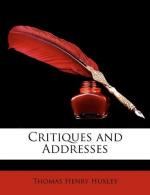Finally, with respect to the development of the moral sense out of the simple feelings of pleasure and pain, liking and disliking, with which the lower animals are provided, I can find nothing in Mr. Wallace’s reasonings which has not already been met by Mr. Mill, Mr. Spencer, or Mr. Darwin.
I do not propose to follow the Quarterly Reviewer and Mr. Mivart through the long string of objections in matters of detail which they bring against Mr. Darwin’s views. Everyone who has considered the matter carefully will be able to ferret out as many more “difficulties;” but he will also, I believe, fail as completely as they appear to me to have done, in bringing forward any fact which is really contradictory of Mr. Darwin’s views. Occasionally, too, their objections and criticisms are based upon errors of their own. As, for example, when Mr. Mivart and the Quarterly Reviewer insist upon the resemblances between the eyes of Cephalopoda and Vertebrata, quite forgetting that there are striking and altogether fundamental differences between them; or when the Quarterly Reviewer corrects Mr. Darwin for saying that the gibbons, “without having been taught, can walk or run upright with tolerable quickness, though they move awkwardly, and much less securely than man.” The Quarterly Reviewer says, “This is a little misleading, inasmuch as it is not stated that this upright progression is effected by placing the enormously long arms behind the head, or holding them out backwards as a balance in progression.”
Now, before carping at a small statement like this, the Quarterly Reviewer should have made sure that he was quite right. But he happens to be quite wrong. I suspect he got his notion of the manner in which a gibbon walks from a citation in “Man’s Place in Nature.” But at that time I had not seen a gibbon walk. Since then I have, and I can testify that nothing can be more precise than Mr. Darwin’s statement. The gibbon I saw walked without either putting his arms behind his head or holding them out backwards. All he did was to touch the ground with the outstretched fingers of his long arms now and then, just as one sees a man who carries a stick, but does not need one, touch the ground with it as he walks along.
Again, a large number of the objections brought forward by Mr. Mivart and the Quarterly Reviewer apply to evolution in general, quite as much as to the particular form of that doctrine advocated by Mr. Darwin; or, to their notions of Mr. Darwin’s views and not to what they really are. An excellent example of this class of difficulties is to be found in Mr. Mivart’s chapter on “Independent Similarities of Structure.” Mr. Mivart says that these cannot be explained by an “absolute and pure Darwinian,” but “that an innate power and evolutionary law, aided by the corrective action of natural selection, should have furnished like needs with like aids, is not at all improbable” (p. 82).
I do not exactly know what Mr. Mivart means by an “absolute and pure Darwinian;” indeed Mr. Mivart makes that creature hold so many singular opinions that I doubt if I can ever have seen one alive. But I find nothing in his statement of the view which he imagines to be originated by himself, which is really inconsistent with what I understand to be Mr. Darwin’s views.




